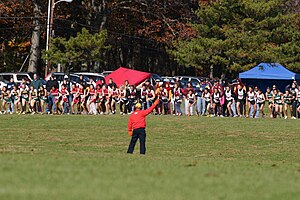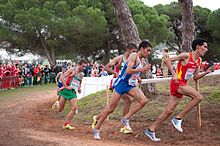Cross country running

|
|
Cross country running is a sport in which teams and individuals run a race on open-air courses over natural terrain such as dirt or grass. Sometimes the runners are referred to as harriers (dogs).[1] The course, typically 4–12 kilometers (2.5–7.5 mi) long, may include surfaces of grass, and earth, pass through woodlands and open country, and include hills, flat ground and sometimes gravel road. It is both an individual and a team sport; runners are judged on individual times and teams by a points-scoring method. Both men and women of all ages compete in cross country, which usually takes place during autumn and winter, and can include weather conditions of rain, sleet, snow or hail, and a wide range of temperatures.
Cross country running is one of the disciplines under the umbrella sport of athletics, and is a natural terrain version of long-distance track and road running. Although open-air running competitions are pre-historic, the rules and traditions of cross country racing emerged in Britain. The English championship became the first national competition in 1876 and the International Cross Country Championships was held for the first time in 1903. Since 1973 the foremost elite competition has been the IAAF World Cross Country Championships.[2]
Race course
Cross country courses are laid out on an open or woodland area. The IAAF recommends that courses be grass-covered, and have rolling terrain with frequent but smooth turns. Courses consist of one or more loops, with a long straight at the start and another leading to the finish line.
Course design
Terrain can vary from open fields to forest hills and even across rivers. It also includes running down and up hills. Because of variations in conditions, international standardization of cross country courses is impossible, and not necessarily desirable. Part of cross country running’s appeal is the distinct characteristics of each venue’s terrain and weather, as in other outdoor sports like motor racing, cycling and golf.
According to the IAAF, an ideal cross country course has a loop of 1,750 to 2,000 meters (1,910 to 2,190 yd) laid out on an open or wooded land. It should be covered by grass, as much as possible, and include rolling hills “with smooth curves and short straights”. While it is perfectly acceptable for local conditions to make dirt or snow the primary surface, courses should minimize running on roads or other macadamized paths. Parks and golf courses often provide suitable locations.
While a course may include natural or artificial obstacles, cross country courses support continuous running, and do not require climbing over high barriers, through deep ditches, or fighting through the underbrush, as do military-style assault courses.[3]
A course at least 5 meters (5.5 yd) full allows competitors to pass others during the race. Clear markings keep competitors from making wrong turns, and spectators from interfering with the competition. Markings may include tape or ribbon on both sides of the course, chalk or paint on the ground, or cones. Some classes use colored flags to indicate directions: red flags for left turns, yellow flags for right turns, and blue flags can mean continue straight ahead or stay within ten feet (of the flag). Courses also commonly include distance markings, usually at each kilometer or each mile.[4]
The course should have 400 to 1,200 m (440 to 1,310 yd) of level terrain before the first turn, to reduce contact and congestion at the start. However, many courses at smaller competitions have their first turn after a much shorter distance.[5]
Distances
Courses for international competitions consist of a loop between 1750 and 2000 meters. Athletes complete three to six loops, depending on the race. Senior men compete on a 12-kilometre course. Senior women and junior men compete on an 8-kilometre course. Junior women compete on a 6-kilometre course.[3]
In the United States, college men typically compete on 8 km (5.0 mi) or 10 km (6.2 mi) courses, while college women race for 5 km (3.1 mi) or 6 km (3.7 mi).[5] High school courses are generally 5 km (3.1 mi). Middle school courses are usually 1.5 mi (2.4 km) or 2 mi (3.2 km) long.
Start
All runners start at the same time, from a starting arc (or line) marked with lines or boxes for each team or individual. An official, 50 meters or more in front of the starting line, fires a pistol to indicate the start. If runners collide and fall within the first 100 meters, officials can call the runners back and restart the race, however this is done only once. Crossing the line or starting before the starting pistol is fired is considered a false start and most often results in disqualification of the runner.
Finish
The course ends at a finish line located at the beginning of a funnel or chute (a long walkway marked with flags) that keeps athletes single-file in order of finish and facilitates accurate scoring.
Depending on the timing and scoring system, finish officials may collect a small slip from each runner’s bib, to keep track of finishing positions. An alternative method (standard in the UK) is to have four officials in two pairs. In the first pair, one official reads out numbers of finishers and the other records them. In the second pair, one official reads out times for the other to record. At the end of the race, the two lists are joined along with information from the entry information. The primary disadvantage of this system is that distractions can easily upset the results, particularly when scores of runners finish close together.
Chip timing has grown in popularity to increase accuracy and decrease the number of officials required at the finish line. Each runner attaches a transponder with RFID to his or her shoe. When the runner crosses the finish line, an electronic pad records the chip number and matches the runner to a database. Chip timing allows officials to use checkpoint mats throughout the race to calculate split times, and to ensure runners cover the entire course. This is by far the most efficient method, although it is also the most expensive. The drawback to chip timing is its inability to separate a close finish properly. Chips times the feet, when the rule books say it is the torso that counts. It is technically possible for an athlete to fall across the finish line, legally crossing the finish line, but with their feet too far away from the sensor to have their finish recorded.
Contemporary races have now started to use fully automatic timing systems for photo finish accuracy to their results. This has dramatically improved the timing mechanisms of Cross Country over the last few years.
Scoring
Scores are determined by summing the top four or five individual finishing places on each team. In international competition, a team typically consists of six runners, with the top four scoring. In the United States, the most common scoring system is seven runners, with the top five scoring. Points are awarded to the individual runners of eligible teams, equal to the position in which they cross the finish line (first place gets 1 point, second place gets 2 points, etc.). The points for these runners are summed, and the lowest score wins. Individual athletes, and athletes from incomplete teams (teams consisting of less than 5 athletes or teams) and individuals who have been disqualified are excluded from scoring. Ties are usually broken by the position of each team’s sixth runner.
The lowest possible score in a five-to-score match is 15 (1+2+3+4+5), achieved by a team’s runners finishing in each of the top five positions. If there is a single opposing team then they would have a score of 40 (6+7+8+9+10), which can be considered a “sweep” for the winning team. In some competitions a team’s sixth and seventh runner are scored in the overall field and are known as “pushers” or “displacers” as their place can count ahead of other runners, giving other teams more points. In the above match, if there are two non-scoring runners and they came 6th and 7th overall, the opponent’s score would be 50 (8+9+10+11+12). Accordingly, the official score of a forfeited dual meet is 15–50.
Strategy
Because of differences between courses in running surface, frequency and tightness of turns, and amount of up and downhill, cross country strategy does not necessarily simplify to running a steady pace from start to finish. Coaches and cross country runners debate the relative merits of fast starts to get clear of the field, versus steady pacing to maximize physiological efficiency. Some teams emphasize running in a group in order to provide encouragement to others on the team, while others hold that every individual should run his or her own race. In addition, whether you run ahead ‘of the pack’ or behind it and pull ahead in the end is important, but can vary according to the runner’s individual skill, endurance, and the length of the race. Runners should also account for food intake prior to the race. Most important, however, is the training beforehand.[6][7][8]
Equipment
Cross country running involves very little specialized equipment. Most races are run in shorts and vests or singlets, usually in club or school colours. In particularly cold conditions, long-sleeved shirts and tights can be worn to retain warmth without losing mobility. The most common footwear are cross country spikes, lightweight racing shoes with a rubber sole and five or more metal spikes screwed into the forefoot part of the sole. Spike length depends on race conditions, with a muddy course appropriate for spikes as long as 25 millimetres (0.98 in). If a course has a harder surface, spikes as short as 6 millimetres (0.24 in) may be most effective. While spikes are suitable for grassy, muddy, or other slippery conditions, runners may choose to wear racing flats, rubber-soled racing shoes without spikes, if the course includes significant portions of paved surfaces or dirt road.[9]













